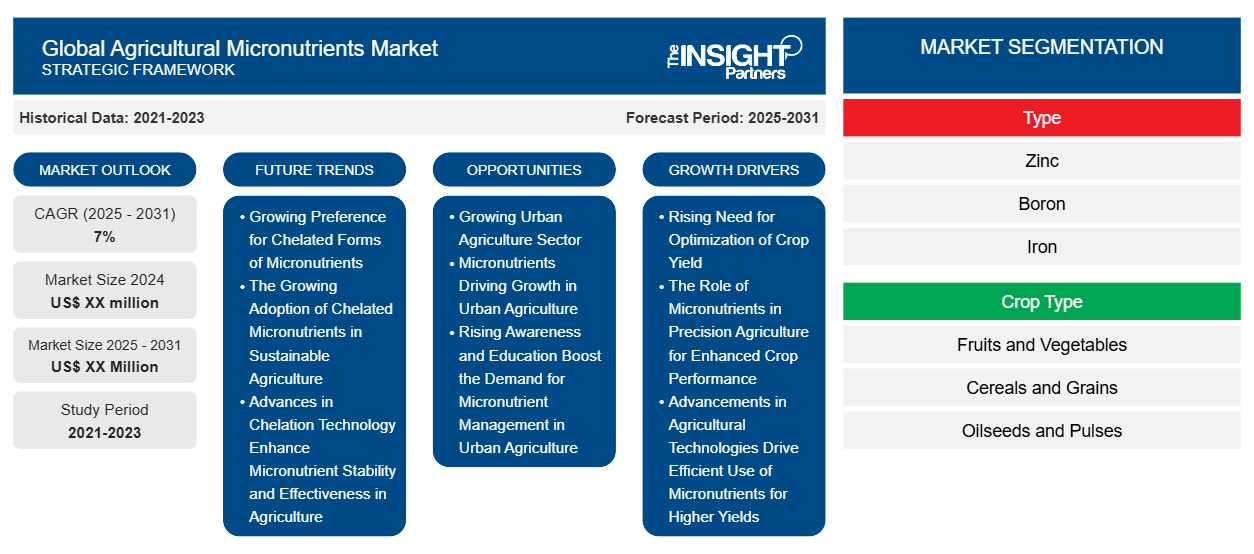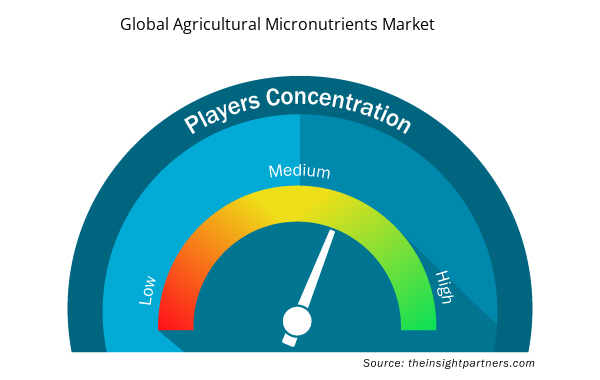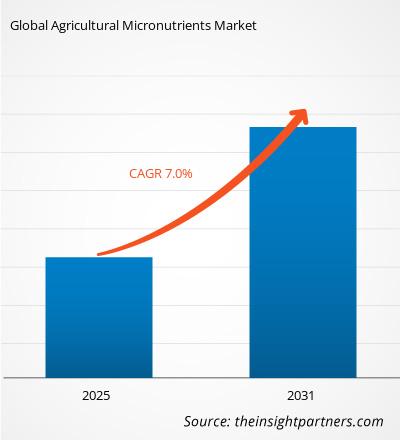The Agricultural Micronutrients Market is expected to register a CAGR of 7% from 2025 to 2031, with a market size expanding from US$ XX million in 2024 to US$ XX Million by 2031.
The report is segmented by Type (Zinc, Boron, Iron, Molybdenum, Copper, Manganese, and Others). The report further presents analysis based on Crop Type (Fruits and Vegetables, Cereals and Grains, Oilseeds and Pulses, and Others). Based on Form report is segmented into (Chelated and Non-Chelated). Based on Mode of Application report is segmented into (Soil, Foliar, Fertigation, and Others). The global analysis is further broken-down at regional level and major countries. The Report Offers the Value in USD for the above analysis and segments.
Purpose of the Report
The report Agricultural Micronutrients Market by The Insight Partners aims to describe the present landscape and future growth, top driving factors, challenges, and opportunities. This will provide insights to various business stakeholders, such as:
- Technology Providers/Manufacturers: To understand the evolving market dynamics and know the potential growth opportunities, enabling them to make informed strategic decisions.
- Investors: To conduct a comprehensive trend analysis regarding the market growth rate, market financial projections, and opportunities that exist across the value chain.
- Regulatory bodies: To regulate policies and police activities in the market with the aim of minimizing abuse, preserving investor trust and confidence, and upholding the integrity and stability of the market.
Agricultural Micronutrients Market Segmentation
Type
- Zinc
- Boron
- Iron
- Molybdenum
- Copper
- Manganese
Crop Type
- Fruits and Vegetables
- Cereals and Grains
- Oilseeds and Pulses
Form
- Chelated and Non-Chelated
Geography
- North America
- Europe
- Asia-Pacific
- South and Central America
- Middle East and Africa
Customize This Report To Suit Your Requirement
You will get customization on any report - free of charge - including parts of this report, or country-level analysis, Excel Data pack, as well as avail great offers and discounts for start-ups & universities
Global Agricultural Micronutrients Market: Strategic Insights

- Get Top Key Market Trends of this report.This FREE sample will include data analysis, ranging from market trends to estimates and forecasts.
Agricultural Micronutrients Market Growth Drivers
- Rising Need for Optimization of Crop Yield: One of the huge impacts that will be accorded to the agricultural micronutrients market is the increase in yield optimization. This will come from farmers' tendency to enhance crop productivity and quality, thus leading to a higher demand for micronutrients such as zinc, iron, and manganese. This has been one of the critical components of plant health and yield, particularly under adverse environmental conditions.
- The Role of Micronutrients in Precision Agriculture for Enhanced Crop Performance: With the rapid growth of the population comes the call for optimized agriculture output, together with food insecurity. To close the gaps of deficiencies within elements that would otherwise limit crop performance, fertilizers and soil amendments are increasingly being brought into the field by farmers. This focus on precision agriculture further heightens awareness of the role of micronutrients in the sustainable practice of agriculture.
- Advancements in Agricultural Technologies Drive Efficient Use of Micronutrients for Higher Yields: Similarly, the high application intensity of micronutrients also comes from agricultural technologies. With improved systems of soil testing and nutrient management, farmers are generally able to increase their inputs with greater care, not only for more remunerative yields but also for more economical resource use to ensure greater profitability in farm operations.
Agricultural Micronutrients Market Future Trends
- Growing Preference for Chelated Forms of Micronutrients: One of the new trends in agricultural micronutrients is the increased demand for chelated forms of micronutrients. Chelated micronutrients are micronutrients chelated to organic molecules, which offer greater bioavailability than traditional forms and, therefore, greater absorption by plants and better crop performance.
- The Growing Adoption of Chelated Micronutrients in Sustainable Agriculture: Another benefit of chelated micronutrient applications reported by the discovery of farmers is their targeted correction of specific nutrient deficiencies in soils. As the awakening environmental consciousness towards nutrient management escalates, these forms are easily adopted as a mode for more and more farmers to enhance plant health and yield. This trend concurs with the call made to all nations worldwide to adopt sustainable agriculture.
- Advances in Chelation Technology Enhance Micronutrient Stability and Effectiveness in Agriculture: Advances in chelation technology from other drivers. Realization of further improvements in the way that chelated micronutrients are formulated to yield greater stability and, therefore, effectiveness. Such new formulations of chelated micronutrients make it easier for them to get applied and thus give better results, an instance forcing broader and more systemic uptake within agricultural sectors.
Agricultural Micronutrients Market Opportunities
- Growing Urban Agriculture Sector: In fact, the growing urban agriculture sector is a very considerable source of growth for the agricultural micronutrient market. As reliance on growing food within cities moves forward as an essential way to fulfill food demands, nutrient management is increasingly important. Micronutrients play a vital role in boosting the productivity of these compact farming systems.
- Micronutrients Driving Growth in Urban Agriculture: New ideas in this area are vertical farming and hydroponics; these cannot operate without precisely formulated nutrients. It is micronutrients that will maximize plant growth in controlled environments, such as in urban agriculture. Urban farmers use these micronutrients to realize higher yields in small, cramped spaces. These micronutrient products are becoming more sought after to be used in urban agricultural settings.
- Rising Awareness and Education Boost the Demand for Micronutrient Management in Urban Agriculture: Increased public awareness regarding education programs and training in the cities creates an increased demand for nutrient management awareness as well. The increase in awareness of the benefits of micronutrients in urban agriculture further adds to the increasing trend of such products. This will, therefore, continue to grow the agricultural micronutrient market as the trend of urban agriculture continues to grow.
Global Agricultural Micronutrients Market Regional Insights
The regional trends and factors influencing the Global Agricultural Micronutrients Market throughout the forecast period have been thoroughly explained by the analysts at Insight Partners. This section also discusses Global Agricultural Micronutrients Market segments and geography across North America, Europe, Asia Pacific, Middle East and Africa, and South and Central America.

- Get the Regional Specific Data for Global Agricultural Micronutrients Market
Global Agricultural Micronutrients Market Report Scope
| Report Attribute | Details |
|---|---|
| Market size in 2024 | US$ XX million |
| Market Size by 2031 | US$ XX Million |
| Global CAGR (2025 - 2031) | 7% |
| Historical Data | 2021-2023 |
| Forecast period | 2025-2031 |
| Segments Covered |
By Type
|
| Regions and Countries Covered | North America
|
| Market leaders and key company profiles |
Global Agricultural Micronutrients Market Players Density: Understanding Its Impact on Business Dynamics
The Global Agricultural Micronutrients Market market is growing rapidly, driven by increasing end-user demand due to factors such as evolving consumer preferences, technological advancements, and greater awareness of the product's benefits. As demand rises, businesses are expanding their offerings, innovating to meet consumer needs, and capitalizing on emerging trends, which further fuels market growth.
Market players density refers to the distribution of firms or companies operating within a particular market or industry. It indicates how many competitors (market players) are present in a given market space relative to its size or total market value.
Major Companies operating in the Global Agricultural Micronutrients Market are:
- BASF SE
- Coromandel International Limited
- Nutrien Ltd.
- The Mosaic Company
- Haifa Group
Disclaimer: The companies listed above are not ranked in any particular order.

- Get the Global Agricultural Micronutrients Market top key players overview
Key Selling Points
- Comprehensive Coverage: The report comprehensively covers the analysis of products, services, types, and end users of the Agricultural Micronutrients Market, providing a holistic landscape.
- Expert Analysis: The report is compiled based on the in-depth understanding of industry experts and analysts.
- Up-to-date Information: The report assures business relevance due to its coverage of recent information and data trends.
- Customization Options: This report can be customized to cater to specific client requirements and suit the business strategies aptly.
The research report on the Agricultural Micronutrients Market can, therefore, help spearhead the trail of decoding and understanding the industry scenario and growth prospects. Although there can be a few valid concerns, the overall benefits of this report tend to outweigh the disadvantages.
- Historical Analysis (2 Years), Base Year, Forecast (7 Years) with CAGR
- PEST and SWOT Analysis
- Market Size Value / Volume - Global, Regional, Country
- Industry and Competitive Landscape
- Excel Dataset


- Lymphedema Treatment Market
- Nuclear Waste Management System Market
- Travel Vaccines Market
- Playout Solutions Market
- Diaper Packaging Machine Market
- Precast Concrete Market
- Lyophilization Services for Biopharmaceuticals Market
- Neurovascular Devices Market
- Cell Line Development Market
- Volumetric Video Market

Report Coverage
Revenue forecast, Company Analysis, Industry landscape, Growth factors, and Trends

Segment Covered
This text is related
to segments covered.

Regional Scope
North America, Europe, Asia Pacific, Middle East & Africa, South & Central America

Country Scope
This text is related
to country scope.
Frequently Asked Questions
Growing Preference for Chelated Forms of Micronutrients is expected to be the key market trends.
Based on geography, Asia Pacific held the largest share of the agricultural micronutrients market.
Based on type, zinc, is expected to witness the fastest growth during the forecast period
BASF SE, Coromandel International Limited, Nutrien Ltd are some of the key players operating in the agricultural micronutrients market
Rising Need for Optimization of Crop Yield is driving the market growth
The Agricultural Micronutrients Market is estimated to witness a CAGR of 7% from 2023 to 2031
Trends and growth analysis reports related to Chemicals and Materials : READ MORE..
The List of Companies
1. BASF SE
2. Coromandel International Limited
3. Nutrien Ltd.
4. The Mosaic Company
5. Haifa Group
6. Yara International ASA
7. Helena Agri-Enterprises LLC
8. Valagro S.p.A
9. Sigma AgriScience, LLC
10. Aries Agro Limited
11. Nufarm Limited
12. AgroLiquid
13. Agrium
14. Akzonobel
15. Dow Chemical
16. ADAMA Agricultural Solutions Ltd.
17. Agrium Inc.
18. Akzo Nobel N.V.
19. Auriga Industries A/S
20.Bayer Crop.

 Get Free Sample For
Get Free Sample For